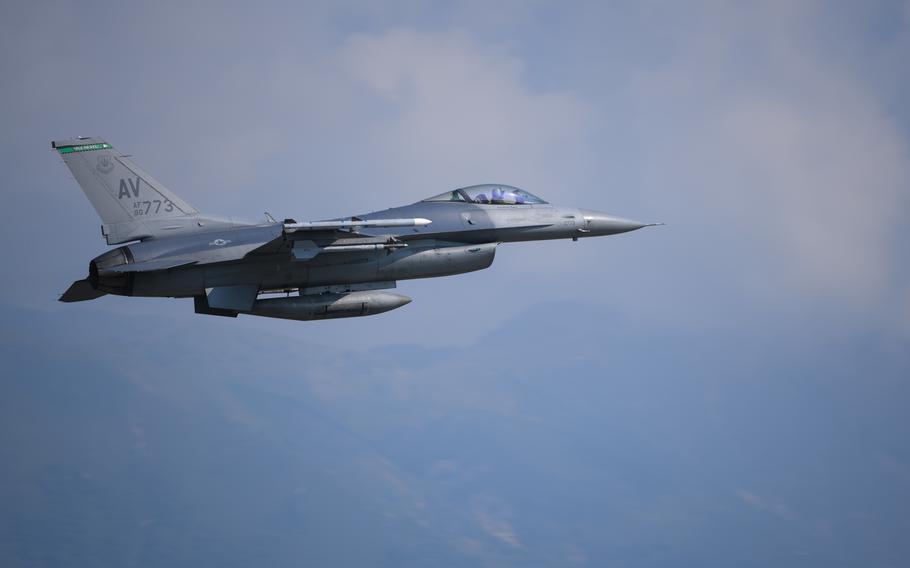
A U.S. Air Force F-16 Fighting Falcon assigned to the 555th Fighter Squadron takes off during exercise Falcon Strike at Aviano Air Base, Italy, June 4, 2021. Falcon Strike 21 is a multi-lateral military training exercise, designed to enhance fourth and fifth generation fighter integration, combat readiness and fighting capability. (Ericka Woolever/U.S. Air Force)
WICHITA, Kan. (Tribune News Service) — Aerospace engineers at Wichita State University will soon have another U.S. military aircraft to disassemble and turn into a 3D replica.
Two Air Force F-16 Fighting Falcons will be delivered to WSU by the end of September as part of a "digital twin" program at National Institute for Aviation Research, university officials announced Wednesday in a news release.
The 3D replica created by NIAR through the four-year project will help extend the operational lifetime of the fighter jet.
"Wichita State's partnership with the F-16 SPO and Lockheed Martin supports sustainment efforts for weapons systems, like the F-16C, that will immediately impact the preparedness of the warfighter," said John Tomblin, WSU senior vice president for Industry and Defense Programs and NIAR executive director, in a statement. "In addition, these programs provide applied learning opportunities for Wichita State graduate and undergraduate students, which, in turn, allows the military to grow its future workforce."
The announcement comes less than a month after an Air Force B-1B bomber fuselage was sent to NIAR. Researchers will look for 35 years’ worth of wear and tear while also creating a "digital twin" of the airplane. NIAR is also working on a digital twin program for the Army's Black Hawk helicopters.
The Air Force Life Cycle Management Center's F-16 Program Office is sponsoring the project. The contract with Wichita State involves disassembling and scanning two F-16s from the 309th Aerospace Maintenance and Regeneration Group at Davis-Monthan Air Force Base.
Researchers will collect data that may be used for digital engineering projects to keep the F-16 fleet operational.
"Our goal is to create a full-scale 3D model of the aircraft, with the exception of the engine," said 1st Lt. Connor Crandall, Digital Twin Program Manager within the Fighters and Advanced Aircraft Directorate, in a WSU news release. "The data will be used to help address future parts obsolescence and mitigate supply chain risks because we won't have to rely on legacy manufacturing sources and processes. We'll have the 3D models and designs that we can send to the manufacturers we choose."
The 3D modeling will be used on some aircraft systems, including environmental control, hydraulic and fuel systems.
NIAR will work with Lockheed Martin on the digital engineering. Aaron Martin, the StarDrive program manager at Lockheed Martin Skunk Works, said the technology investments will help the Air Force save time and money on maintenance.
"Maintainers and engineers work diligently to deliver aircraft to the fight, and it costs a lot of time, money and effort to break out an aircraft for updates and repairs," said Capt. Jamee Boyer, an F-16 structural engineer, in a statement. "It also costs money to develop a solution that doesn't really work.
"With a 3D model, we can model different solutions in a virtual environment and see if they work, before having maintainers remove parts that may not need to be removed. Consequently, this would reduce maintenance workload, provide an innovative tool for engineers and prevent aircraft being removed from the flying schedule."
The work of NIAR could also lay the foundation for potential augmented reality and virtual reality training for aircrew and maintainers.
The first F-16 flight was in December 1976, according to the Air Force's fact sheet, which was published in 2015. The compact, multi-role fighter is highly maneuverable and fights in both air-to-air combat and air-to-surface attacks. The aircraft is "a relatively low-cost, high-performance weapon system for the United States and allied nations."
Each F-16C/D aircraft cost $18.8 million, in Fiscal Year 98 constant dollars. The total force inventory was 1,017 fighters as of 2015. The USAF has more F-16s than any other aircraft in its fleet.
The Fighting Falcon was originally built under a consortium between the United States and four NATO allies: Belgium, Denmark, the Netherlands and Norway. Portugal has since joined the consortium. Since Sept. 11, 2001, the F-16 has been a major component of the combat forces committed to the war on terrorism.
Additional countries have purchased fighters. In May, the Air Force Life Cycle Management Center reported that 25 nations are operating F-16s. The production line in Greenville, South Carolina, has focused on foreign sales, and Air Force Magazine reported that newly produced F-16s could still be flying into the 2070s.
(c)2021 The Wichita Eagle (Wichita, Kan.)
Visit The Wichita Eagle (Wichita, Kan.) at www.kansas.com
Distributed by Tribune Content Agency, LLC.